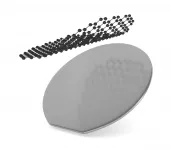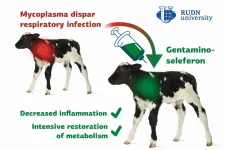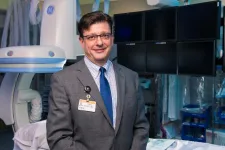INFORMATION:
A scalable method for the large-area integration of 2D materials
Graphene Flagship researchers report a new method to integrate graphene and 2D materials into semiconductor manufacturing lines, a milestone for the recently launched 2D-EPL project.
2021-02-10
(Press-News.org) Two-dimensional (2D) materials have a huge potential for providing devices with much smaller size and extended functionalities with respect to what can be achieved with today's silicon technologies. But to exploit this potential we must be able to integrate 2D materials into semiconductor manufacturing lines - a notoriously difficult step. A team of Graphene Flagship researchers in Sweden and Germany now reports a new method to make this work.
The technique, just published in Nature Communications by researchers from Graphene Flagship partners RWTH Aachen University, Universität der Bundeswehr München and AMO GmbH, in Germany, Graphene Flagship Associate Member KTH Royal Institute of Technology, in Sweden, in collaboration with Protemics GmbH.
The integration of 2D materials with silicon or with a substrate with integrated electronics presents a number of challenges. "There's always this critical step of transferring from a special growth substrate to the final substrate on which you build sensors or components," says Arne Quellmalz, researcher at Graphene Flagship Associate Member KTH and lead author of the paper. "You might want to combine a graphene photodetector for optical on-chip communication with silicon read-out electronics, but the growth temperatures of those materials is too high, so you cannot do this directly on the device substrate."
So far, most of the experimental methods for transferring 2D materials from their growth substrate to the desired electronics are either non compatible with high-volume manufacturing or lead to a significant degradation of the 2D material and of its electronic properties. The beauty of the solution proposed by Quellmalz and co-workers is that it lies in the existing toolkits of semiconductor manufacturing: to use a standard dielectric material called bisbenzocyclobutene (BCB), along with conventional wafer bonding equipment.
"We basically glue the two wafers together with a resin made of BCB," explains Quellmalz. "We heat the resin, until it becomes viscous, like honey, and press the 2D material against it." At room temperature, the resin becomes solid and forms a stable connection between the 2D material and the wafer, he says. "To stack materials, we repeat the steps of heating and pressing. The resin becomes viscous again and behaves like a cushion, or a waterbed, which supports the layer stack and adapts to the surface of the new 2D material."
The researchers demonstrated the transfer of graphene and molybdenum disulfide (MoS2), as a representative for transition metal dichalcogenides, and stacked graphene with hexagonal boron nitride (hBN) and MoS2 to heterostructures. All transferred layers and heterostructures were reportedly of high quality, that is, they featured uniform coverage over up to 100-millimeter sized silicon wafers and exhibited little strain in the transferred 2D materials.
"Our transfer method is in principle applicable to any 2D material, independent of the size and the type of growth substrate", says Prof. Max Lemme, from Graphene Flagship partners AMO GmbH and RWTH Aachen University. "And, since it relies only on tools and methods that are already common in the semiconductor industry, it could substantially accelerate the appearance on the market of a new generation of devices where 2D materials are integrated on top of conventional integrated circuits or microsystem. This work is an important step towards this goal and, although many further challenges remain, the range of potential applications is large: from photonics, to sensing, to neuromorphic computing. The integration of 2D materials could be a real game-changer for the European high-tech industry."
Recently, the European Commission launched a €20 million project to bridge the gap between lab-scale manufacturing and large volume production of electronic devices based on two-dimensional materials, the Graphene Flagship 2D Experimental Pilot Line (2D-EPL). "This paper is a good example of the work that we carry out in the 2D-EPL project," says Cedric Huyghebaert, program manager for exploratory materials and module integration at imec and technical leader of the 2D-EPL project. "This is one of our urgent tasks at the moment is to develop tool kits and design manuals for manufacturing devices based on 2D materials that are compatible with the standards of semiconductor industry", says Huyghebaert. "The next step will be to demonstrate the potential of these processes for producing innovative sensors and optoelectronic devices on a pilot line."
ELSE PRESS RELEASES FROM THIS DATE:
Young and restless, old and focused: Age-differences in mind-wandering
2021-02-10
New research from Trinity College Dublin suggests that older adults can be more focused, less impeded by anxiety and less mentally restless than younger adults. The team at the Trinity College Institute of Neuroscience (TCIN) (today, Wednesday, 10th February, 2021) show that older adults appear to mitigate the negative aspects of cognitive decline by increasing motivation and adopting more efficient strategies to suspend the wandering mind when focus is required.
The study, published in the journal Psychology and Aging (American Psychological Association) is the first to adjudicate between competing theories of age-related ...
Vitamin D supplementation: possible gain in life years combined with cost savings
2021-02-10
In recent years, three meta-analyses of clinical studies have come to the conclusion that vitamin D supplementation was associated with a reduction in the mortality rate from cancer of around 13 percent. Scientists at the German Cancer Research Center (DKFZ) have now transferred these results to the situation in Germany and calculated: If all Germans over the age of 50 were to take vitamin D supplements, up to 30,000 cancer deaths per year could possibly be avoided and more than 300,000 years of life could be gained - in addition, health care costs could be saved.
For several years now, scientists have been investigating the influence of an adequate supply of vitamin D on the ...
Why overfishing leads to smaller cod
2021-02-10
Overfishing, hunting and intensive agriculture and forestry can sometimes contribute to plants and animals becoming endangered. New research from Lund University in Sweden and University of Toronto can now show why this leads to entire populations becoming smaller in size, as well as reproducing earlier. The study is published in the journal PNAS.
Researchers from Lund and Toronto are behind the study conducted on five different species of damselflies. They have studied how different environmental factors affect when and at what size the damselflies begin to reproduce. In the study, the researchers also shed light on how overfishing off the coast ...
A rare observation of a vampire bat adopting an unrelated pup
2021-02-10
COLUMBUS, Ohio - The death of a vampire bat 19 days after giving birth presented scientists studying the animals in 2019 with an unexpected chance to observe a rare event: a female bat's adoption of an unrelated baby.
The researchers had captured common vampire bats in Panama as part of ongoing studies of the formation of cooperative relationships among strangers. The team used infrared surveillance cameras to observe six hours of vampire bat activity spaced over the span of each day.
Two unrelated and unfamiliar female bats were observed forming a social bond based on mutual grooming and food sharing that increased over time. The researchers had named them BD and Lilith.
Lilith ...
RUDN University veterinarians tested a new drug against pneumonia in calves
2021-02-10
Respiratory tract diseases in young animals of the cattle are a big issue for world agriculture and food safety because a bacterium that causes them is resistant to most antibiotics. A team of veterinarians from RUDN University developed and tested a complex preparation called gentaminoseleferon that could help treat respiratory infection in calves. The results of the study were published in the Veterinary World journal.
Bacteria of the genus Mycoplasma cause many infectious diseases in animals, including atypical pneumonia, other respiratory tract conditions, reproductive pathologies, arthritis, keratoconjunctivitis, mastitis, and so on. The genus includes about 200 species of bacteria, and all of them ...
New weapon against resistant bacteria
2021-02-10
Every day, people die from simple infections even though they have been treated with antibiotics. This is because more and more bacteria have become resistant to the types of antibiotics that doctors can prescribe.
- It's a huge societal problem and a crisis that we must solve. For example, by developing new antibiotics that can defeat the resistant bacteria, says professor of chemistry at the Department of Physics, Chemistry and Pharmacy, University of Southern Denmark, Poul Nielsen.
Resistant bacteria are not only known from pig farms, where it is becoming increasingly difficult to keep the pigsties disease-free. Hospitals are also experiencing with increasing regularity that, for example, infectious diseases cannot be controlled in patients. Thus, ...
Long-term stress linked to increased risk of heart attack
2021-02-10
Can long-term stress lead to heart attacks? Most people would probably answer in the affirmative, but the scientific evidence of this is scarce. A new study by researchers from Linköping University in Sweden reveals that the levels of the stress hormone cortisol were increased in the months preceding a heart attack. The results, published in Scientific Reports, suggest that long-term stress is a risk factor for heart attacks.
"The levels of the stress hormone cortisol differed between people who have had a heart attack and those not affected. This suggests that cortisol in hair may be a new risk marker for heart attacks. We must take stress seriously", says Professor Tomas Faresjö from the Department of Health, ...
Endovascular aneurysm repair linked to higher readmission rates
2021-02-10
Ruptured abdominal aortic aneurysms (rAAA) are responsible for nearly 2% of all deaths in U.S. men over the age of 65. Endovascular aneurysm repair (EVAR) has emerged as a newer and less invasive alternative to open repair for rAAA, and current guidelines recommend EVAR as a first-line option for treatment of rAAA when certain criteria are met. But researchers from the University of Missouri School of Medicine have discovered that while EVAR is more commonly utilized for rAA, shortens hospital stay and has a lower initial mortality rate, the odds of ...
A recipe for regenerating bioengineered hair
2021-02-10
Researchers at the RIKEN Center for Biosystems Dynamics Research in Japan have discovered a recipe for continuous cyclical regeneration of cultured hair follicles from hair follicle stem cells.
Scientists have been making waves in recent years by developing ways to grow a variety of useful items in laboratories, from meat and diamonds to retinas and other organoids. At the RIKEN Center for Biosystems Dynamics Research in Japan, a team led by Takashi Tsuji has been working on ways to regenerate lost hair from stem cells. In an important step, a new study identifies a population of hair follicle stem cells in the skin and a recipe for normal cyclical regeneration in the lab.
The researchers took fur and whisker cells ...
On the origin of our species
2021-02-10
Experts from the Natural History Museum, The Francis Crick Institute and the Max Planck Institute for the Science of Human History Jena have joined together to untangle the different meanings of ancestry in the evolution of our species Homo sapiens.
Most of us are fascinated by our ancestry, and by extension the ancestry of the human species. We regularly see headlines like 'New human ancestor discovered' or 'New fossil changes everything we thought about our ancestry', and yet the meanings of words like ancestor and ancestry are rarely discussed in detail. In the new paper, published in Nature, experts review our current understanding of how modern human ancestry around the globe can be traced into the distant ...
LAST 30 PRESS RELEASES:
Stardust study resets how life’s atoms spread through space
Practical education: Clinical scenario-based program development
The impact of family dynamics on eating behaviour – how going home for Christmas can change how you eat
Tracing the quick synthesis of an industrially important catalyst
New software sheds light on cancer’s hidden genetic networks
UT Health San Antonio awarded $3 million in CPRIT grants to bolster cancer research and prevention efforts in South Texas
Third symposium spotlights global challenge of new contaminants in China’s fight against pollution
From straw to soil harmony: International team reveals how biochar supercharges carbon-smart farming
Myeloma: How AI is redrawing the map of cancer care
Manhattan E. Charurat, Ph.D., MHS invested as the Homer and Martha Gudelsky Distinguished Professor in Medicine at the University of Maryland School of Medicine
Insilico Medicine’s Pharma.AI Q4 Winter Launch Recap: Revolutionizing drug discovery with cutting-edge AI innovations, accelerating the path to pharmaceutical superintelligence
Nanoplastics have diet-dependent impacts on digestive system health
Brain neuron death occurs throughout life and increases with age, a natural human protein drug may halt neuron death in Alzheimer’s disease
SPIE and CLP announce the recipients of the 2025 Advanced Photonics Young Innovator Award
Lessons from the Caldor Fire’s Christmas Valley ‘Miracle’
Ant societies rose by trading individual protection for collective power
Research reveals how ancient viral DNA shapes early embryonic development
A molecular gatekeeper that controls protein synthesis
New ‘cloaking device’ concept to shield sensitive tech from magnetic fields
Researchers show impact of mountain building and climate change on alpine biodiversity
Study models the transition from Neanderthals to modern humans in Europe
University of Phoenix College of Doctoral Studies releases white paper on AI-driven skilling to reduce burnout and restore worker autonomy
AIs fail at the game of visual “telephone”
The levers for a sustainable food system
Potential changes in US homelessness by ending federal support for housing first programs
Vulnerability of large language models to prompt injection when providing medical advice
Researchers develop new system for high-energy-density, long-life, multi-electron transfer bromine-based flow batteries
Ending federal support for housing first programs could increase U.S. homelessness by 5% in one year, new JAMA study finds
New research uncovers molecular ‘safety switch’ shielding cancers from immune attack
Bacteria resisting viral infection can still sink carbon to ocean floor
[Press-News.org] A scalable method for the large-area integration of 2D materialsGraphene Flagship researchers report a new method to integrate graphene and 2D materials into semiconductor manufacturing lines, a milestone for the recently launched 2D-EPL project.





